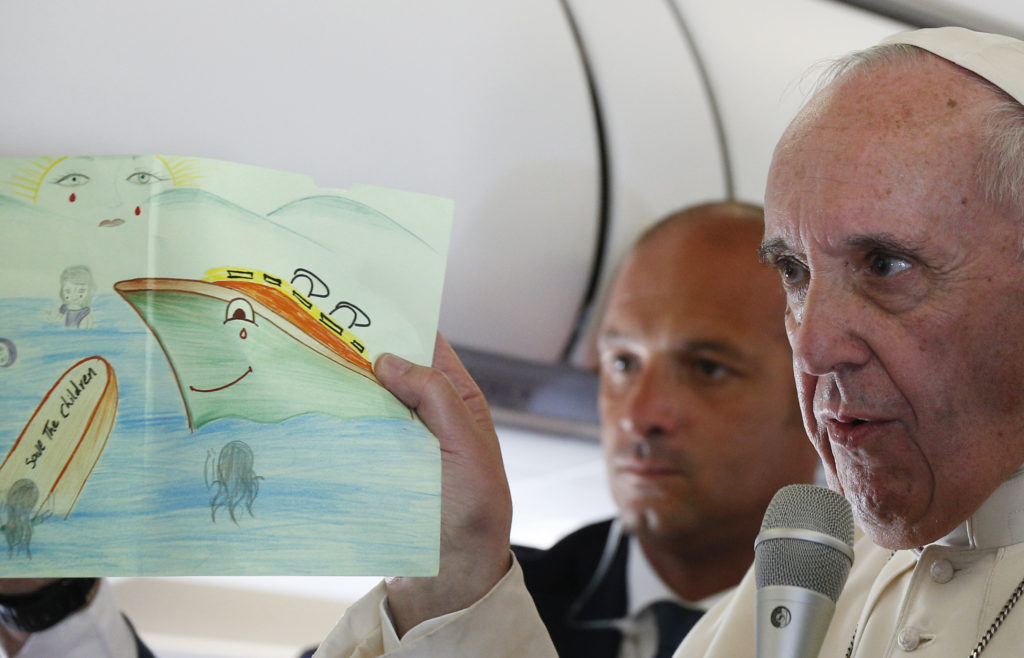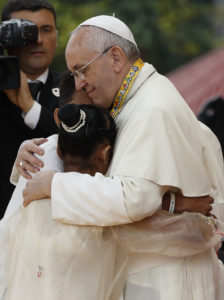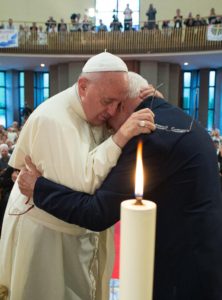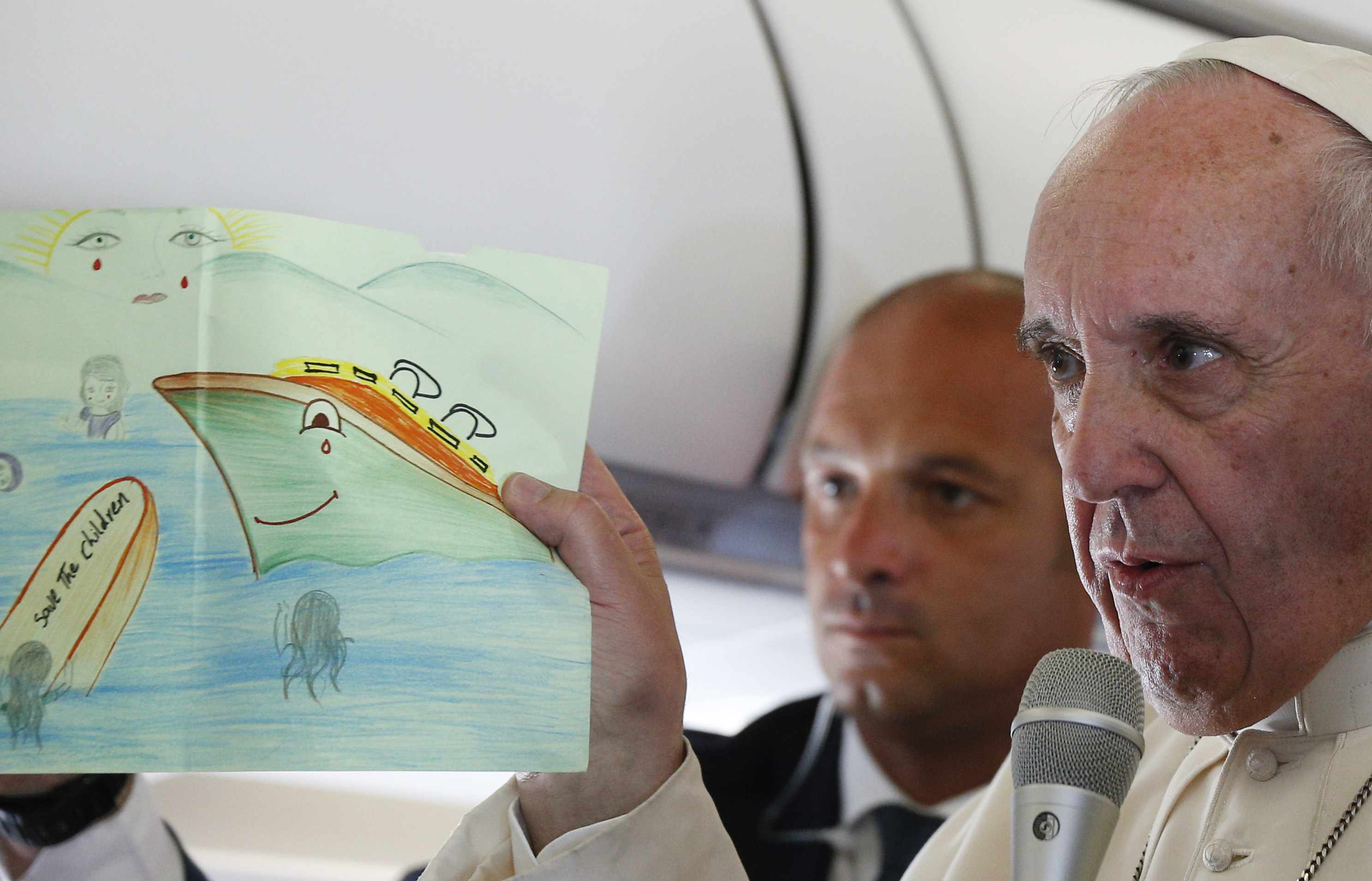
VATICAN CITY (CNS) — Throughout his pontificate, Pope Francis has been sharing a theology of tears: tears of compassion, compunction and consolation.
Although Pope Francis does not mask his emotions in public, he rarely is seen to cry. One obvious exception was in Albania in September 2014 when he came face to face with a priest who had been imprisoned and tortured for his faith under the country’s communist regime. After a long embrace with the priest and some whispered words, the pope turned from the congregation to wipe the tears from his eyes.
Pope Francis encourages people to pray for “the grace of tears” when pleading to God to help others, when recognizing their own sinfulness, when contemplating the greatness of Christ’s sacrifice on the cross and when experiencing God’s mercy.
As part of the Holy Year of Mercy, the pope scheduled a May 5 prayer vigil “to dry the tears” of those who are weeping, inviting parents who have lost a child, victims of war and torture, the seriously ill, the desperate, those enslaved by addiction and everyone else in need of consolation.

[quote_box_left]
Photos
May 5 prayer vigil
An ocean of tears calls for mercy, compassion
[/quote_box_left]
Sometimes, he has said, tears are the only true response to the question of why the innocent suffer.
In January 2015, the pope listened to a 14-year-old boy in Manila describe life on the streets as a struggle to find food, to fight the temptation of sniffing glue and to avoid adults looking for the young to exploit and abuse. Related article
A 12-year-old girl, rescued from the streets by the same foundation that helped the boy, covered her face with her hand as she wept in front of the pope. But she managed to ask him, “Why did God let this happen to us?”
Pope Francis said a real answer was impossible, but the question itself was important and the tears that accompanied the question were even more eloquent than the words.
“Certain realities of life,” he said, “are seen only with eyes that are cleansed by tears.”
For people who are safe, comfortable and loved, he said, learning how to weep for others is part of following Jesus, who wept at the death of Lazarus and was moved with compassion at the suffering of countless others.
“If you do not know how to weep, you are not a good Christian,” the pope said in Manila.
When the pope talks about tears, he’s “very Latin and very Ignatian,” said Jesuit Father Daniel Huang, the order’s regional assistant for Asia and the Pacific. A flow of tears indicates that the person’s heart is involved, not just his or her mind.
In his Spiritual Exercises and his Spiritual Diary, St. Ignatius of Loyola — founder of the Jesuits — urges his confreres to request the gift of tears and recounts how often in prayer and in celebrating Mass the gift of tears was given to him.
In the first week of the Spiritual Exercises, St. Ignatius suggests those making the retreat may want to pray for the grace “to weep abundantly either over one’s sins or over the pains and sorrows endured by Christ our Lord.”

Crying in grief over one’s sins or out of compassion for Christ’s suffering, Fr. Huang said, are moments when “I overcome my self-preoccupation or my hardness of heart or my indifference — that’s what the pope talks about all the time.”
The tears of compassion for Christ’s suffering by extension becomes weeping for the suffering of refugees, or the sick or people in mourning, he said.
“Tears presumably come from a deep place within and tears suggest you are not just thinking, you are feeling, your heart is involved,” the Jesuit said.
The ability to shed tears is “a grace” that allows a person to express his or her humanity and connection to other human beings, he said. It expresses “what is best in humanity — that we feel compassion for people and that we are moved by people’s suffering.”
Returning to Rome in mid-April after a one-day visit with refugees in Greece, Pope Francis told reporters traveling with him that the situation of the refugees, what they experienced getting to Greece and how they are living in the refugee camp “makes you weep.”
Going to the back of the plane where the media were seated, the pope carried some of the drawings the refugee children had given him. He explained the trauma the children had experienced and showed one picture where the child had drawn the sun crying.
“If the sun is able to cry, we should be able to shed at least one tear,” he said. “A tear would do us good.”
In meetings with priests, Pope Francis repeatedly asks if they are able to weep when pleading to God in prayer to help their parishioners. He told priests of the Diocese of Rome in 2014 that the old Missal had a prayer that “began like this: ‘Lord, who commanded Moses to strike the rock so that water might gush forth, strike the stone of my heart so that tears…’ — the prayer went more or less like this. It was very beautiful.”
“Do you weep?” he asked the priests. “Or in this priesthood have we lost our tears?”
In Pope Francis’ teaching, tears — and the suffering that causes them — also can be a step toward renewed faith and clarity about the love of God.
“You see, sometimes in our lives, the glasses we need to see Jesus are tears,” he said at a morning Mass early in his papacy. “All of us in our lives have gone through moments of joy, pain, sadness — we’ve all experienced these things.”
“In the darkest moments, did we cry?” he asked his small congregation, which included Vatican police and firefighters. “Have we received that gift of tears that prepares our eyes to see the Lord?”







